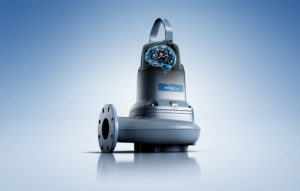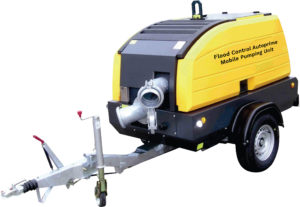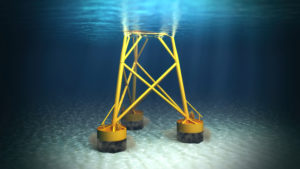Saving What Can be Saved
When floods rise, pumping systems can prevent catastrophes. They continue to be in demand, as the number of floods keeps increasing worldwide.
The images on TV are becoming more frequent: reports on floods have meanwhile become all too common in the news. In the last years, the USA and Asia suffered especially, and numerous lives were lost. This year, France and the south of Germany were hit hard, amongst others. Floods cannot be prevented. Intelligent prevention protection can, however, contain the damages, and as such spare people from the horrendous costs. Pumps are contributing their share, in an ever growing way.
Man and industry at risk
High water and floods are a risk for lives, buildings and industry. The losses are enormous. The German Environment Agency UBA provides several examples just how a factory can suffer: tanks can become buoyant, tearing apart pipelines. Buoyancy and external pressure deforms tanks and containers, inventory turns into flotsam, springing a leak into tanks. Power cables can tear, and chemical storages are flooded and washed over. Finally, transformer stations and treatment plants fail.
Torrential rain, high water and floods can even result in stored raw materials becoming a threat to the environment, and the populace. Advanced plant technology is also prone to great damages.
Prepared against floods
Such worst case scenarios make companies tremble. The Chempark Leverkusen acted. It expanded its flood protection through the construction of fixed and mobile protective barriers, as well as through a floodwater pumping station with a design-flood laid out for a catastrophic event that could happen every 200 years.
Surface water and cooling water is discharged into the Rhine using gravity pipelines when the water-level is normal, explains the UBA. In the case of high water, the pipelines are sealed in the Chempark. “In this case surface water and cooling water is lifted from the canal by high-performance pumps and conveyed into the Rhine at a substantially higher level,” explains the German Environment Agency.
“Pumps are to ensure a tailback in the canal does not lead to a flood within the plant, for example through cooling water,” says Michael Nassenstein, spokesperson for Currenta, the company responsible for the Chempark Leverkusen. Apparatuses and tanks are, if necessary, secured against buoying upwards, or can be secured through directed flooding. “If the Chempark is endangered despite the aforementioned measures, the production facilities can be shut down rapidly”.
The hazard potential is nonetheless low: the protective mechanisms allow fifty companies – with around 27,700 employees – to continue production in the Chempark Leverkusen. This protection serves as a role model.
Global demand on the rise
Floods are becoming worse, and this has direct consequences for pump manufacturers and dealers. “Demand for pumps is growing worldwide – climate change and soil sealing are an international problem, emphasises Dirk Schmitz, head of communication at pump manufacturer Grundfos. And there is no end in sight. According to a study of the German Insurance Association (GDV) extreme weather will occur more often, and fiercely, in the upcoming decades. For the Rhine, Elbe, Weser, Ems and Donau rivers, the study predicts damage to buildings and infrastructure to double, if not even triple.
Already now, “floods are the most quickly rising worldwide source of environmental catastrophes, while at the same 50 percent of the global population lives in deltas that are prone to flooding,” explains Schmitz. This means “that the requirements for flood production and also pumping systems will rise substantially”.
Fixed and mobile pumps
For effective protection, there is no single, go-to pump. Instead, the range of pumps is tailored to fit the needs of the various end users. While companies and municipalities mainly use stationary solutions for flood prevention, house owners mainly need mobile pumps for basement drainage, alongside fixed pumping equipment. Mobile pumps are supposed to be as light as possible.
The flood issue is not only sharpening in Europe – such as in France or South Germany this year – but is also responsible for even more dramatic catastrophes around the globe. Floods in China three years ago resulted in 85 deaths, in 2014 over 30 lives were lost in the Balkans.
And what are the reasons behind the spike of floods threatening mankind around the world? Several reasons are responsible. Climate change is leading to frequent periods with high levels of rainfall. Depending on region, natural floodplains and flood detention areas are being destroyed, rivers regulated and straightened, and streams canalised. An increase in soil sealing leads to rain directly flowing into rivers, explains the city of Cologne’s municipal drainage operation, StEB. Forest death also forces danger of flooding, intact forests absorb rainfalls like a sponge.
Dangerous heavy rains and flash floods
“If a river is conveying floodwater, the chance of a basic stage flood in the region also rises,” explains StEB. The effect is the same in the case of protracted wet periods. Groundwater normally flows through underground cavities below the surface into rivers. A high groundwater level, however, can’t be absorbed anymore by a river and its shore area. “Groundwater accumulates and finds an alternative path: it rises upwards. The result is a so-called basic stage flood”. A basic stage flood occurs delayed, often enough after the flood as such has drained away. “Such floods can hit regions far away from waterbodies,” adds Cologne’s StEB.
Heavy rain and flash floods are also a growing threat. Heavy rain sees the average precipitation of a month fall within just a few minutes, or hours. The ground doesn’t have enough time to absorb the additional water. Floods are even worse after a previous dry period. “Instead of seeping away, the water flows over large areas of hard soil,” emphasises the municipal drainage operation of Cologne.
Investments “under high pressure”
The growing dangers of flooding is causing a lot of hustle and bustle for governments and municipalities. In Germany, the environmental ministers conference agreed on a national flood protection programme coordinated by the federal government, following the devastating floods in the Danube and Elbe regions in June 2013. “Under high pressure”, as the Federal Environment Ministry put it, a prioritised list of supra-regional flood protection measures was to be created, and measures approved. “The national flood protection programme sees dyke relocation, projects for controlled flood retention (i.e. flood polders), as well as measures to eliminate weak points,” reports the ministry. The preliminary total sum of budgetary sums for all measures amounts to around 5.4 billion euro.
As a matter of course, investments made into flood protection also increase demand for pumps. Pumps, however, that can meet certain requirements. Flood protection requires pumps that offer a high delivery rating and a low pumping head. “A high level of dependability is especially important, so pumps can start up again when necessary after a long standstill,” explains Dirk Schmitz, head of communication at Grundfos. The company’s axial-propeller flow pumps for flood protection are equipped with Turbulence Optimiser technology. The technology serves to reduce turbulence in the gap between the pump volute and the column pipe, “increasing efficiency by up to two percentage points”. The pumps are also able to handle sandy waters, oils and rags.
Pumping systems and floodgates
And how can additional protection look like? If backflows pose the threat of flooding seemingly unendangered regions, construction of large floodgates with high-performance motors is an option. Floodgates normally stand open, and are only closed if water levels rise, preventing a backflow upriver. “The pumps installed at the floodgates prevent the water level from increasing in the secondary flow over the water level of the watergate’s upstream water”, explains Schmitz. When the water level in the tailwater of the floodgate reaches the normal level again, the gates open up again.
Construction of such a protective measure needs to be well-considered. A company needs to be involved early in the planning phase of flood control measures, in order to make sure all decisive factors are taken into account in design and construction. “This includes, amongst others, the design of the pumping stations and the retention basins, pump selection, consideration of future requirements, as well as a critical look at life cycle costs,” states Schmitz.
Pump industry is needed
The broad range of products shows that Grundfos sees a high commercial potential in the ‚Flood Control‘ business. A potential, which also sees other manufacturers and dealers invest in pumps for flood protection. And for good reasons. Fire brigades are the anchors for man, animal and buildings when floods strike. As such, they have been equipped with a growing amount of pumps in the last few years. Following the floods in 2013, donations were used to buy 46 floodwater pumps in the German district of Landshut. An investment which paid of this year. Once again the district in Bavaria had to fight with floods, but was now able to handle the aftermaths.The pump sector is badly needed – in the future even more than today.
Source: Messe Düsseldorf GmbH






